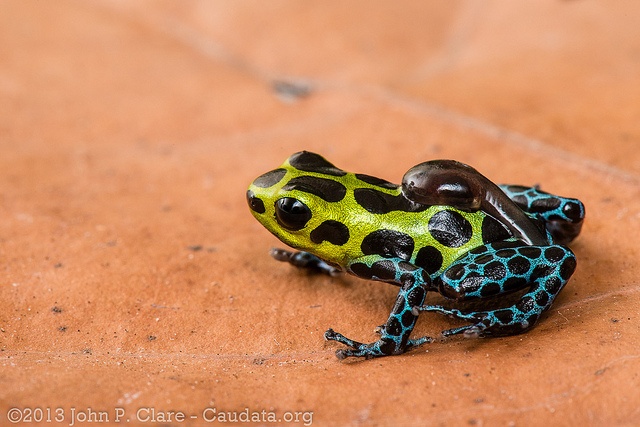Tadpoles are in a great hurry to get away
Things go bad if sibling larvae of the splash-back poison frog Ranitomeya variabilis grow up together: only one of them will survive. So, as soon as an adult frog approaches, tadpoles try to climb on its back and to get a ride to a safe place, Lisa Schulte and Michael Mayer write.
Mating pairs of the splash-back poison frog Ranitomeya variabilis, that occurs in Peru, lay two to six eggs at the surface of small water bodies in plants, for instance Bromelia species. In such ‘phytotelmata’ the risk for the eggs to be found by a predator is small. Later, the male returns to retrieve each larva upon hatching and transports it on its back to an unoccupied phytotelm that he already selected. He then returns to fish the next larva out of the water, until all the young are singly housed in different phytotelmata.
Quickly
It is necessary for the larvae to get separated from each other, as the tadpoles are cannibalistic. If they stay together, only one of them will survive and grow up.
In some cases, however, the male doesn’t return to retrieve the hatching larvae. In such case, the abandoned tadpoles actively seek transport, as Lisa Schulte and Michael Mayer show. They collected clutches of eggs, took them to the lab and kept them in small plastic cups. After the tadpoles hatched, they were kept together and the researchers introduced an adult frog. That frog was either a conspecific male or a conspecific female, or a male of a different species.
In all cases, the tadpoles approached the adult frog, and many of them tried to climb onto its back quickly. Some succeeded. They actually jumped on the frog’s back, the researchers report; it looked like an attack.
High need
The tadpoles have a good reason to be so desperate. In a natural situation, a frog that shows up most likely is the male parent frog that revisits the phytotelm to save its young from cannibalism. The first tadpole to approach will be assisted to mount; the male will bend its back or push it up with its legs. After the male left with this lucky tadpole, there is no guarantee that he will return to get the other ones. If he can’t find an unoccupied phytotelm anymore, he will stay away. Hence the haste of the tadpoles.
But in the experiments, the visiting frog could also be a female, or a male of another species. In such cases, the tadpoles did not get any help. Yet they tried to get transport by mounting this frog on their own.
Obviously, the need to be saved is so high that the tadpoles don’t make any difference between their father and any other frog that happens to appear. And they had better not, because even a frog with no intention to bring tadpoles to a safe place may visit an unoccupied phytotelm, and rescue the hitchhiker.
However, when the researchers offered a plastic frog model, the tadpoles did not respond. They probably recognize a true frog by chemical cues.
Willy van Strien
Photo: John Clare (via Flickr. Creative Commons CC BY-NC-ND 2.0)
Source:
Schulte, L.M. & M. Mayer, 2017. Poison frog tadpoles seek parental transportation to escape their cannibalistic siblings. Journal of zoology, 5 mei online. Doi: 10.1111/jzo.12472
